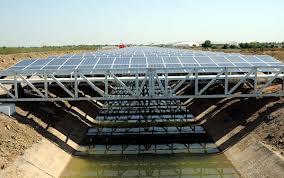Solar Canals
A 1 MW solar panel project has been
built over nearly half a mile of the Narmada Canal in the state of Gujarat in
India. The state government has reported
that, this project will not only produce electricity but also conserve land and
water. The project is meant to show an efficient use of land in an agricultural
region by putting solar panels over a waterway rather than over fertile ground.
It also should reduce evaporation of the canal water by an estimated 237,750
gallons of water each year, the state government said. The Gujarat State Electricity Corp. developed the project and hired U.S.-based SunEdison to build
it.
Figure 1 : Solar Panels over the Narmada Canal, India
The idea of putting solar panels over water to save land and water isn’t new, but it’s not widely deployed either. A New York Times story published in 2011 outlined several projects – including two at California vineyards – that have done so by installing solar panels over ponds. Over 144 solar panels sit atop pontoons moored on a three-acre irrigation pond surrounded by vineyards in Petaluma in Sonoma County. Some 35 miles to the north, in the heart of the Napa Valley, another array of 994 solar panels covers the surface of a pond at the Far Niente Winery. However, an official from the state agency overseeing the aqueduct expressed concerns over the stability of solar panels and the ability of repair workers to fix leaks and other problems at the 400-mile canal if they have to contend with massive structures of solar panels and their mounting systems.
Figure 2 : Solar Canals Over a Floating Pontoon at The Niente Winery, Napa Valley, California
Video 1 : Solar Canals Over a Floating Pontoon at The Niente Winery, Napa Valley, California
The state of Gujarat has been developing
the solar power project over the past few years. This state, which encourages
solar energy installation by guaranteeing premium prices for the solar
electricity, boasts at least 600 MW of solar and 2,580 MW of wind energy
generation, which makes it one of the largest renewable energy producing state
in the country. With that much solar and wind developed, Gujarat officials said
they had achieved their renewable energy purchase goal. It’s unclear whether
that means renewable energy project development will slow.
The 1 MW project only covers a small
section of the canal, whose main waterway runs nearly 285 miles. If you add all
the side channels, then the overall length is about 11,806 miles. So there is
still plenty of space to put more solar panels over them.
This practice will certainly contribute
towards efficient energy generation. The idea of solar panels on water can be
effectively implemented when trying to achieve the Living Building Challenge
because of the scale jumping opportunities for on-site renewable energy
especially around regions where the availability of land is rather scarce.



Comments
Post a Comment